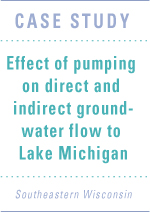 EFFECT OF PUMPING FROM WELLS ON DIRECT AND INDIRECT GROUND-WATER FLOW TO A GREAT LAKE EFFECT OF PUMPING FROM WELLS ON DIRECT AND INDIRECT GROUND-WATER FLOW TO A GREAT LAKE
The development of cities and farms changes the relation of ground water to the Great Lakes:
First and foremost, pumping from wells causes less water to discharge to the Lakes or
even reverses flow.
Some of the water diverted from the Lake by wells can be captured by man-made structures and returned to the Lake as discharge from a storm sewer or water-treatment plant. But in this case the timing, location, and quality of the discharge water is changed from the natural ground-water regime.
Pumping is intense around parts of the Great Lakes:
Pumping has caused flow directions to change and ground-water divides to
shift:
Some ground water that once circulated entirely within the Great Lakes
basin now flows to wells outside the basin and is ultimately discharged as
waste water to rivers that don't return to the Great Lakes but flow
elsewhere (for example, to the Mississippi River):
return to top |